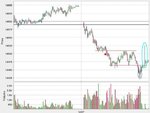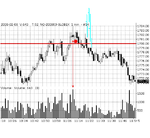firewalker99
Legendary member
- Messages
- 6,655
- Likes
- 613
But, yes, if the market does not do what's expected, I close out the trade. This is not a stop. This is an exit. A stop is determined ahead of time. I have no idea what the market is going to do after my entry ahead of time. Therefore, there is no therefore.
Perhaps this could all be cleared up by the simple use of some formal unambiguous definitions. If I understand correctly, you consider stops to be a way of closing out a trade by means that have been determined ahead of time. Exits are determined on the spot in real time, depending on market action (in your case price & volume). Some might argue that stops are just a part of an exit strategy, but if you know what you know what you are looking for before/U] you enter the trade. Yes, you don't think what could/should/would happen, but nevertheless you have scenario's at hand which you will apply depending on what hand the market shows you. One might say this is not predetermined because the price level where his stop/exit/target or whatever you want to call it, isn't fixed, but the price-volume pattern he is looking for is. Otherwise there would be no reason to enter nor exit a trade.
However, you've mentioned on several occasions you trade price from S to R and the other way around and you don't get out until you see a reversal signal. But having S/R as targets, is basically saying you dó have exits which are determined ahead of time. I take it you don't immediately close out your trade when price reaches the next S/R, but instead wait to see how price reacts to it (vigorously with a bounce, very low volume reaction, etc...). Nevertheless you are saying - in advance - that you will not exit your trade until price reached at a minimum those levels and you pretty much "don't care what happens along the way".
I can see how this is different from the trader who has determined in advance that he will for example (a) exit if price does not move in his direction in the first 5 minutes or (b) exit with a loss if price goes in the wrong direction by a certain amount of points, but it comes down to the same: you know what it is you are looking for and you will close out the trade when that happens.
It's like crossing the street: you know that - after you have looked left and right and left and right a second time - you will cross the street if there are no cars approaching. You have determined beforehand what action you will take, depending on what reality shows you. These decisions on what to do have been made long before, what the person who's crossing the road is doing, is merely acting on what he has always considered to be a valid signal, based on previous teachings, studies or experience. Likewise for a trader.
Last edited:



